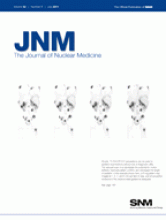Index by author
Cover image

Shorter 18F-FDG PET/CT acquisitions can be used for pediatric examinations without loss of diagnostic utility. The reduced scan time decreases the potential for motion artifacts, improves patient comfort, and decreases the length of sedation. In the example shown here, a 61-kg patient was imaged at 1, 2, 3, and 5 min per field of view, and all acquisition durations in this instance were graded as adequate.
See page 1028.



